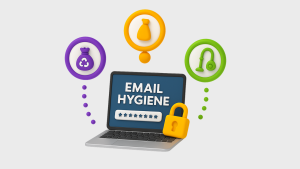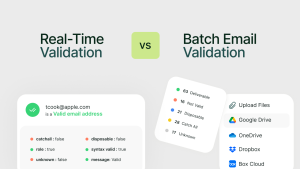Email marketing success depends on one core factor: whether your emails actually reach the inbox.
When invalid or risky email addresses fill your database, your bounce rate increases, and email service providers (ESPs) start to question your credibility.
This guide explains how email validation and verification directly reduce bounce rate and safeguard your sender reputation — a key requirement for high email deliverability.
What is Email Bounce Rate?
Bounce rate = % of emails rejected by the receiving SMTP server.
Two types:
| Type | Meaning | Risk Level |
|---|---|---|
| Hard Bounce | Invalid / non-existent mailbox | 🚨 Severe — damages sender reputation immediately |
| Soft Bounce | Mailbox full / temporary issue | ⚠ Can still hurt reputation if repeated |
📌 ESPs like Gmail, Outlook, and Yahoo track bounce rates to judge trustworthiness.
📉 If your bounce rate exceeds 2%, inbox placement begins to drop.
Why Email Validation Is Crucial for Businesses
Email validation is the process of analyzing email addresses to ensure:
✔ Syntax is valid
✔ Domain exists & has SPF/DKIM/DMARC records
✔ Mailbox is active
✔ Email is not a spam trap or disposable address
✔ Not a role-based account like support@ / hr@
This helps marketers maintain email hygiene and protect email infrastructure.
📌 Learn more: Email Validation Accuracy: Metrics & Benchmarks
How Email Validation Reduces Bounce Rate
Invalid contacts directly lead to hard bounces → ESPs blacklist your domain/IP.
Email validation prevents:
❌ Fake signups
❌ Misspelled emails
❌ Abandoned accounts
❌ Catch-all domain rejections
❌ Disposable emails used only for gated content
➡ By removing these risks proactively, you maintain a clean email list — reducing bounces by 95%+.
How Validation Protects Your Sender Reputation
Your sender reputation score determines whether recipients see:
📥 Inbox
⚠ Promotions
🚫 Spam folder
🛑 Blocked
Email service providers evaluate:
| Factor | How Validation Helps |
|---|---|
| Bounce history | Removes undeliverable addresses |
| Spam trap incidents | Detects risky domains |
| User engagement | Higher open & click-through rates |
| Complaint rates | Prevents unsolicited messages |
| Domain & IP reputation | Preserves trust with ESPs |
🛡 Validation + proper authentication (SPF, DKIM, DMARC) strengthen domain legitimacy.
📌 Explore: Authentication + Validation: Why SPF, DKIM & DMARC Matter
Validation Across the Email Lifecycle
Validation improves three major deliverability phases:
| Stage | Use Case | Benefit |
|---|---|---|
| Pre-capture | Real-time email validation in forms | Stops fake leads instantly |
| Database maintenance | Bulk list cleaning | Removes risky inactive contacts |
| Campaign monitoring | Bounce & reputation tracking | Continuous email hygiene |
📌 Fore more info : Real-Time vs Batch Email Validation: Which Should You Use?
Business Outcomes of Lower Bounce Rates
✔ Higher inbox placement
✔ Stronger domain reputation
✔ Reduced cost of sending to invalid emails
✔ Better analytics accuracy
✔ Higher email marketing ROI
One bounce avoided = money saved + trust earned ✔
Avoid Blacklists & Spam Traps with Validation
Spam traps are used by anti-spam organizations to detect senders with poor list quality.
Validation helps identify:
- Spam traps
- Role-based addresses
- Disposable domains
- Catch-all mailboxes
➡ Prevent blacklisting and expensive deliverability issues.
Quick Tip for Marketers
Validate regularly with reputed Email validation Tool : before uploading contacts to CRM + before every major campaign.
Conclusion
Email validation is not optional anymore — it’s the foundation of:
✔ Sender reputation
✔ Inbox placement
✔ Campaign profitability
A clean list today means
➡ A stronger domain tomorrow
➡ A healthier marketing pipeline always
Monitor, clean, and protect your email reputation.
👉 Try Gamalogic Email Validation API — prevent bounces before they damage your domain.
You might also like

Email Hygiene Uncovered: Tips for Maintaining Spotless Email Data
Poor email hygiene can lead to bounced messages, damaged sender reputations, and missed business opportunities. In this guide, we uncover practical tips and strategies to help you maintain a spotless email list, improve deliverability, and ensure your communications always hit the mark.

Real-Time vs Batch Email Validation: When to Use Each
Real-Time vs Batch Email Validation: When to Use Each? In this guide, we’ll break down the difference between real-time and batch (bulk) email validation

The Cold Email Hack You’re Missing: Catch-All Email Validation Explained!
Tired of cold emails going nowhere? Don’t let invalid addresses ruin your outreach efforts. Discover how catch-all email validation can protect your brand’s reputation, reduce bounce rates, and boost deliverability. Learn how to identify risky email domains, filter spam, and optimize your email campaigns with smarter validation—before you hit send. Real lessons, real impact—see how digital marketers are winning with catch-all email verification.






 No credit card required
No credit card required


Post your Comment.